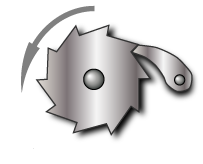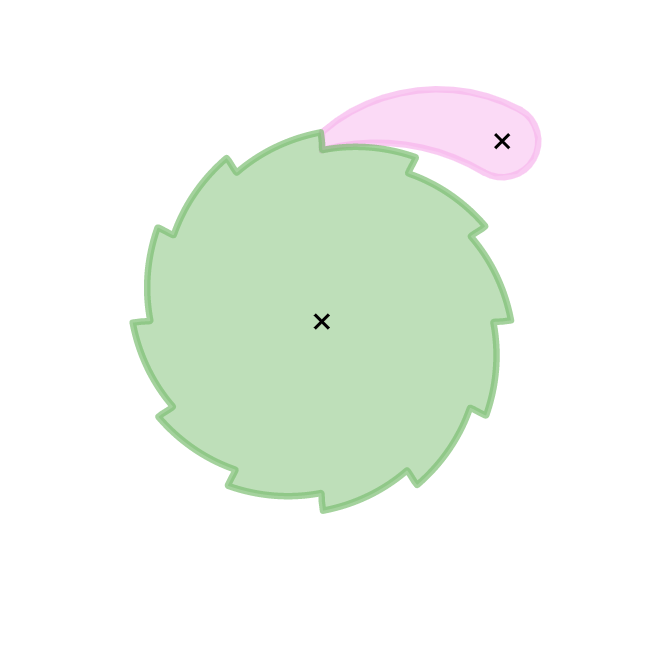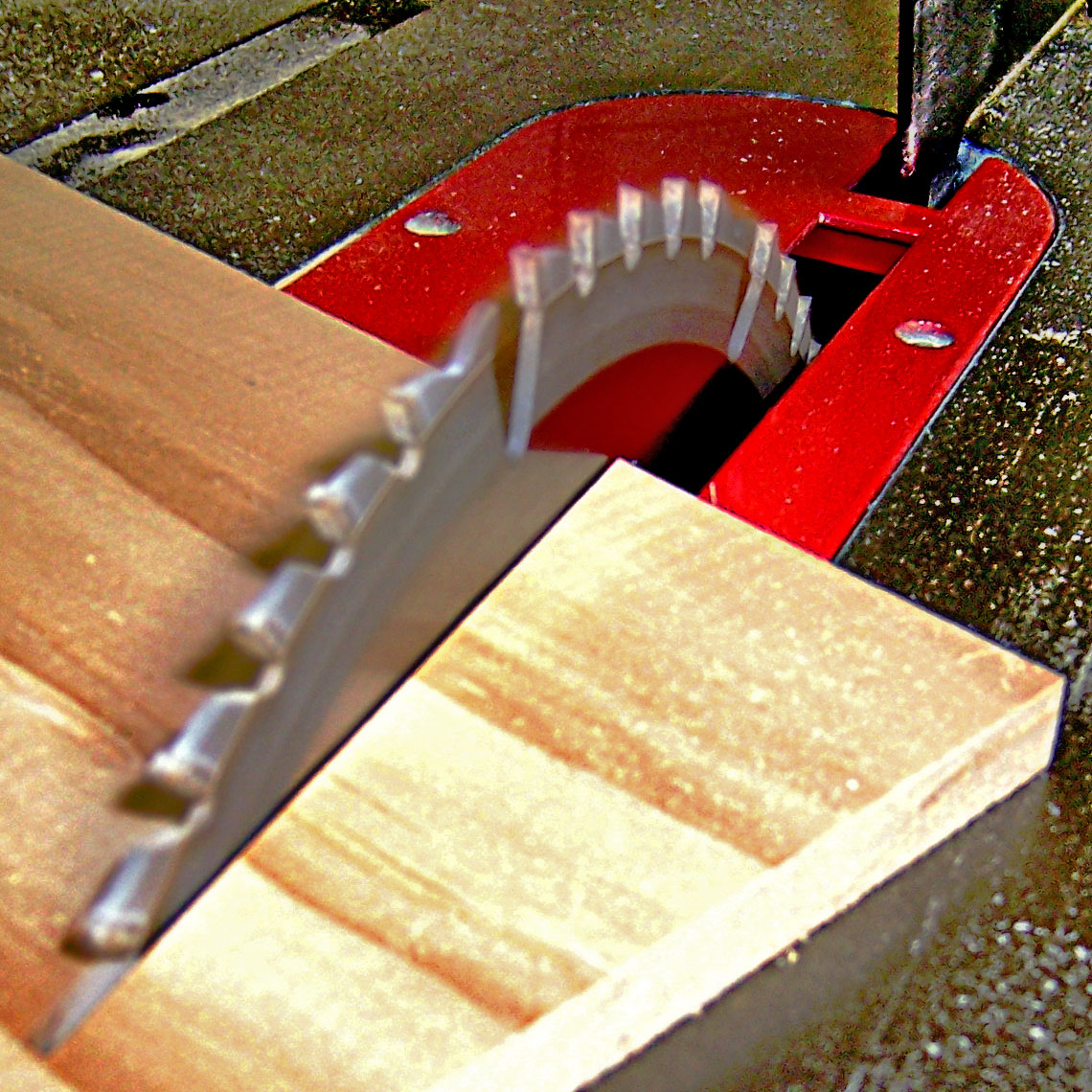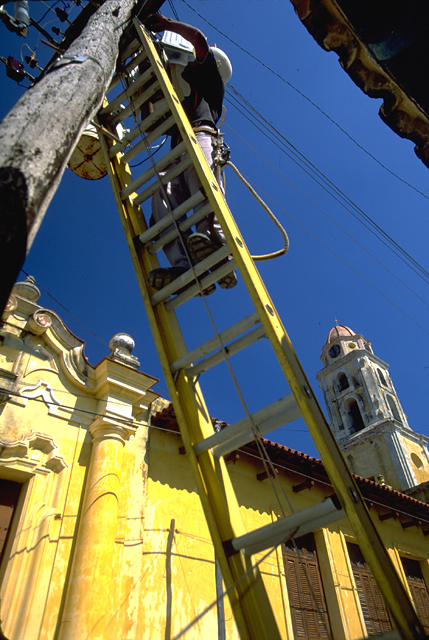|
Pawl
A pawl is a movable lever that engages a fixed component to either prevent movement in one direction or restrain it altogether. As such, it is a type of latch and can also be considered a type of dog. It typically consists of a spring-loaded lever that engages a mating component at a steep enough angle to restrain it. Pawls are often tapered, being widened at their pivot for anchoring and narrow at their tip. Applications ;Anchor windlass: A pawl is used in an anchor windlass to prevent a free-spooling chain by grabbing and snubbing an individual link. Similar mechanisms include a Devil's claw, or a claw and dog. ;Ratchet: A pawl is used in combination with a ratchet gear in socket wrenches, bicycle freehubs, winches, and many other applications. ;Ladder: Dogs (in the form of pawls) are used on extension ladders to temporarily anchor their sections to one-another. ;Table saw: Pawls are used on table saws to prevent a workpiece being sawn from kicking back. ;Transmission: A ... [...More Info...] [...Related Items...] OR: [Wikipedia] [Google] [Baidu] |
Parking Pawl
A parking pawl is a device fitted to a motor vehicle's automatic transmission that locks up the transmission when the transmission shift lever selector is placed in the Park position. "Park" is the first position of the lever (topmost on a column shift, frontmost on a floor shift) in all cars sold in the United States since 1965 (when the order was standardised by the ''Society of Automotive Engineers'' (SAE)) through ''SAE J915'', and in most other vehicles worldwide. Design and operation The parking pawl locks the transmission's ''output shaft'' to the transmission casing by engaging a ''pawl'' (a pin) that engages in a notched wheel on the shaft, stopping it (and thus the driven wheels) from rotating. The main components of a parking pawl mechanism are the parking gear, parking pawl, actuator rod, cam collar, cam plate, pivot pin, and parking pawl return spring. The mechanism assembly is designed so that the parking pawl tooth collides and overrides the parking gear teeth (ratc ... [...More Info...] [...Related Items...] OR: [Wikipedia] [Google] [Baidu] |
Ratchet (device)
A ratchet (occasionally spelled rachet) is a mechanical device that allows continuous linear or rotary motion in only one direction while preventing motion in the opposite direction. Ratchets are widely used in machinery and tools. The word ''ratchet'' is also used informally to refer to a ratcheting socket wrench. __TOC__ Theory of operation A ratchet consists of a round gear or a linear rack with teeth, and a pivoting, spring-loaded finger called a '' pawl'' (or ''click'', in clocks and watches) that engages the teeth. The teeth are uniform but are usually asymmetrical, with each tooth having a moderate slope on one edge and a much steeper slope on the other edge. When the teeth are moving in the unrestricted (i.e. forward) direction, the pawl easily slides up and over the gently sloped edges of the teeth, with a spring forcing it (often with an audible 'click') into the depression between the teeth as it passes the tip of each tooth. When the teeth move in the opposite ... [...More Info...] [...Related Items...] OR: [Wikipedia] [Google] [Baidu] |
Pawl Brake (English)
A pawl is a movable lever that engages a fixed component to either prevent movement in one direction or restrain it altogether. As such, it is a type of latch and can also be considered a type of dog. It typically consists of a spring-loaded lever that engages a mating component at a steep enough angle to restrain it. Pawls are often tapered, being widened at their pivot for anchoring and narrow at their tip. Applications ;Anchor windlass: A pawl is used in an anchor windlass to prevent a free-spooling chain by grabbing and snubbing an individual link. Similar mechanisms include a Devil's claw, or a claw and dog. ;Ratchet: A pawl is used in combination with a ratchet gear in socket wrenches, bicycle freehubs, winches, and many other applications. ;Ladder: Dogs (in the form of pawls) are used on extension ladders to temporarily anchor their sections to one-another. ;Table saw: Pawls are used on table saws to prevent a workpiece being sawn from kicking back. ;Transmission: A ... [...More Info...] [...Related Items...] OR: [Wikipedia] [Google] [Baidu] |
Table Saw
A table saw (also known as a sawbench or bench saw in England) is a woodworking tool, consisting of a circular saw blade, mounted on an arbor, that is driven by an electric motor (either directly, by belt, or by gears). The blade protrudes through the top of a table, which provides support for the material, usually wood, being cut. In most modern table saws, the depth of the cut is varied by moving the blade up and down: the higher the blade protrudes above the table, the deeper the cut that is made in the material. In some early table saws, the blade and arbor were fixed, and the table was moved up and down to expose more or less of the blade. The angle of cut is controlled by adjusting the angle of blade. Some earlier saws angled the table to control the cut angle. Types The general types of table saws are compact, benchtop, jobsite, contractor, hybrid, cabinet, and sliding table saws. Benchtop Benchtop table saws are lightweight and are designed to be placed on a table o ... [...More Info...] [...Related Items...] OR: [Wikipedia] [Google] [Baidu] |
Anchor Windlass
A windlass is a machine used on ships that is used to let-out and heave-up equipment such as a ship's anchor or a fishing trawl. On some ships, it may be located in a specific room called the windlass room. An anchor windlass is a machine that restrains and manipulates the anchor chain on a boat, allowing the anchor to be raised and lowered by means of chain cable. A notched wheel engages the links of the chain or the rope. A trawl windlass is a similar machine that restrains or manipulates the trawl on a commercial fishing vessel. The trawl is a sort of big fishing net that is wound on the windlass. The fishermen either let-out the trawl or heave-up the trawl during fishing operations. A brake is provided for additional control. The windlass is usually powered by an electric or hydraulic motor operating via a gear train. Horizontal or vertical Technically speaking, the term "windlass" refers only to horizontal winches. Vertical designs are correctly called capstans. Horizon ... [...More Info...] [...Related Items...] OR: [Wikipedia] [Google] [Baidu] |
Anchor Windlass
A windlass is a machine used on ships that is used to let-out and heave-up equipment such as a ship's anchor or a fishing trawl. On some ships, it may be located in a specific room called the windlass room. An anchor windlass is a machine that restrains and manipulates the anchor chain on a boat, allowing the anchor to be raised and lowered by means of chain cable. A notched wheel engages the links of the chain or the rope. A trawl windlass is a similar machine that restrains or manipulates the trawl on a commercial fishing vessel. The trawl is a sort of big fishing net that is wound on the windlass. The fishermen either let-out the trawl or heave-up the trawl during fishing operations. A brake is provided for additional control. The windlass is usually powered by an electric or hydraulic motor operating via a gear train. Horizontal or vertical Technically speaking, the term "windlass" refers only to horizontal winches. Vertical designs are correctly called capstans. Horizon ... [...More Info...] [...Related Items...] OR: [Wikipedia] [Google] [Baidu] |
Dog (engineering)
In engineering, a dog is a tool or part of a tool, such as a pawl, that prevents or imparts movement through physical engagement. It may hold another object in place by blocking it, clamping it, or otherwise obstructing its movement. Or it may couple various parts together so that they move in unison – the primary example of this being a flexible drive to mate two shafts in order to transmit torque. Some devices use dog clutches to lock together two spinning components. In a manual transmission, the dog clutches, or "dogs" lock the selected gear to the shaft it rotates on. Unless the dog is engaged, the gear will simply freewheel on the shaft. This word usage is a metaphor derived from the idea of a dog (animal) biting and holding on, the "dog" name derived from the basic idea of how a dog jaw locks on, by the movement of the jaw, or by the presence of many teeth. In engineering the "dog" device has some special engineering work when making it – it is not a simple part to ma ... [...More Info...] [...Related Items...] OR: [Wikipedia] [Google] [Baidu] |
Extension Ladder
A ladder is a Vertical direction, vertical or inclined set of rungs or Step (footing), steps used for climbing or descending. There are two types: rigid ladders that are self-supporting or that may be leaned against a vertical surface such as a wall, and rollable ladders, such as those made of rope or aluminium, that may be hung from the top. The vertical members of a rigid ladder are called stringers or rails (US) or stiles (UK). Rigid ladders are usually portable, but some types are permanently fixed to a structure, building, or equipment. They are commonly made of metal, wood, or fiberglass, but they have been known to be made of tough plastic. Historical usages Ladders are ancient tools and technology. A ladder is featured in a Mesolithic rock painting that is at least 10,000 years old, depicted in the Cuevas de la Araña, Spider Caves in Valencia, Spain. The painting depicts two humans using a ladder to reach a wild honeybee nest to harvest honey. The ladder is depicted as ... [...More Info...] [...Related Items...] OR: [Wikipedia] [Google] [Baidu] |
Latch
A latch or catch (called sneck in Northern England and Scotland) is a type of mechanical fastener that joins two (or more) objects or surfaces while allowing for their regular separation. A latch typically engages another piece of hardware on the other mounting surface. Depending upon the type and design of the latch, this engaged bit of hardware may be known as a ''keeper'' or ''strike''. A latch is not the same as the locking mechanism of a door or window, although often they are found together in the same product. Latches range in complexity from flexible one-piece flat springs of metal or plastic, such as are used to keep blow molded plastic power tool cases closed, to multi-point cammed latches used to keep large doors closed. Common types Deadbolt latch A single-throw bolt. The bolt can be engaged in its strike plate only after the door is closed. The locking mechanism typically prevents the bolt from being retracted by force. Spring latches * Latch bolt An extrem ... [...More Info...] [...Related Items...] OR: [Wikipedia] [Google] [Baidu] |
Socket Wrench
A socket wrench (or socket spanner) is a type of spanner (or wrench in North American English) that uses a closed ''socket'' format, rather than a typical open wrench/spanner to turn a fastener, typically in the form of a nut or bolt. The most prevalent form is the ratcheting socket wrench, often informally called a ratchet. A ratchet incorporates a reversible ratcheting mechanism which allows the user to pivot the tool back and forth to turn its socket instead of removing and repositioning a wrench to do so. Other common methods of driving sockets include pneumatic impact wrenches, hydraulic torque wrenches, torque multipliers and breaker bars. Some lesser known hybrid drivers include striking wrench tools with square drive, and hydraulic impact wrenches (typically powered by on site hydraulic power such as present with military tanks, and many rail car applications). The basic contemporary form of socket is hexagonal, referred to as "6-point" for the pointed intersections ... [...More Info...] [...Related Items...] OR: [Wikipedia] [Google] [Baidu] |
Winch
A winch is a mechanical device that is used to pull in (wind up) or let out (wind out) or otherwise adjust the tension of a rope or wire rope (also called "cable" or "wire cable"). In its simplest form, it consists of a spool (or drum) attached to a hand crank. Traditionally, winches on ships accumulated wire or rope on the drum; those that do not accumulate, and instead pass on the wire/rope (see yacht photo above), are called capstans. Despite this, sailboat capstans are most often referred to as winches. Winches are the basis of such machines as tow trucks, steam shovels and elevators. More complex designs have gear assemblies and can be powered by electric, hydraulic, pneumatic or internal combustion drives. It might include a solenoid brake and/or a Mechanical brake stretch wrapper, mechanical brake or ratchet (device), ratchet and pawl which prevents it unwinding unless the pawl is retracted. The rope may be stored on the winch. When trimming a line on a sailboat, the ... [...More Info...] [...Related Items...] OR: [Wikipedia] [Google] [Baidu] |
Freehub
A freehub is a type of bicycle hub that incorporates a ratcheting mechanism. A set of sprockets (called a "cassette") is mounted onto a splined shaft of the freehub to engage the chain. The ratcheting mechanism is a part of the hub, in contrast to a freewheel, an older technology, which contains both the sprockets and a ratcheting mechanism in a single unit separate from the hub. In many high-end and midrange bicycles, freehubs have replaced freewheel systems. A freewheel mechanism allows a rider to stop pedalling whilst the cycle is still in forward motion. On a cycle without a freewheel mechanism, the rider has to keep pedalling whenever the cycle is moving. Comparison to freewheels The freehub concept answers several drawbacks encountered with the freewheel design: * Freewheels are threaded onto an axle hub, using conventional right-hand threads. As the bicycle rider pedals, the freewheel is continuously kept tight, as chain torque is in the right-hand direction. This be ... [...More Info...] [...Related Items...] OR: [Wikipedia] [Google] [Baidu] |



.png)





